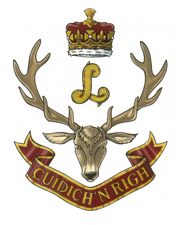The Seaforth Highlanders of Canada
| The Seaforth Highlanders of Canada | |
|---|---|

Seaforth Highlanders of Canada Heraldry
|
|
| Active | 1910–present |
| Country |
|
| Branch |
|
| Type | Light Infantry |
| Role | To close with and destroy the enemy |
| Size | Battalion |
| Part of |
39 Canadian Brigade Group 3rd Canadian Division |
| Garrison/HQ | Seaforth Armoury, Vancouver, British Columbia |
| Motto(s) | Cuidich'n Righ (Aid the King) |
| March | The Piobaireachd of Donald Dhu |
| Commanders | |
| Colonel-in-Chief | HRH The Duke of Edinburgh |
| Notable commanders |
Major General Bert Hoffmeister |
| Insignia | |
| Tartan | Seaforth MacKenzie |
| Abbreviation | Seaforth of C |
 |
|
| Location | Vancouver, British Columbia |
|---|---|
| Website | http://seaforthhighlanders.ca/organization/seaforth-museum/ |
The Seaforth Highlanders of Canada is a Primary Reserve infantry regiment of the Canadian Army based in Vancouver, British Columbia. The regiment is subordinate to 39 Canadian Brigade Group, 3rd Canadian Division. Based at the Seaforth Armoury on Burrard Street in Vancouver, the regiment serves in both times of war and civil emergency, such as disaster relief after earthquakes or floods. It also contributes individual volunteers or "augmentees" to Canadian Forces operations around the world.
The regiment was formed in 1910 and served overseas in both World War I and World War II. Members of the Seaforth Highlanders have deployed on many missions since World War II including Korea, Egypt, Cyprus, Croatia and most recently in Afghanistan.
Lineage of the Seaforth Highlanders of Canada:
The 72nd Battalion (Seaforth Highlanders of Canada), CEF was authorized on 10 July 1915 and embarked for Britain on 23 April 1916. It disembarked in France on 13 August 1916, where it fought as part of the 12th Infantry Brigade, 4th Canadian Division in France and Flanders until the end of the war. The battalion disbanded on 30 August 1920.
The 231st Battalion (Seaforth Highlanders of Canada), CEF was authorized on 15 July 1916 and embarked for Britain on 11 April 1917, where, on 22 April 1917, its personnel were absorbed by the 24th Reserve Battalion, CEF to provide reinforcements for the Canadian Corps in the field. The battalion disbanded on 11 April 1918.
...
Wikipedia
